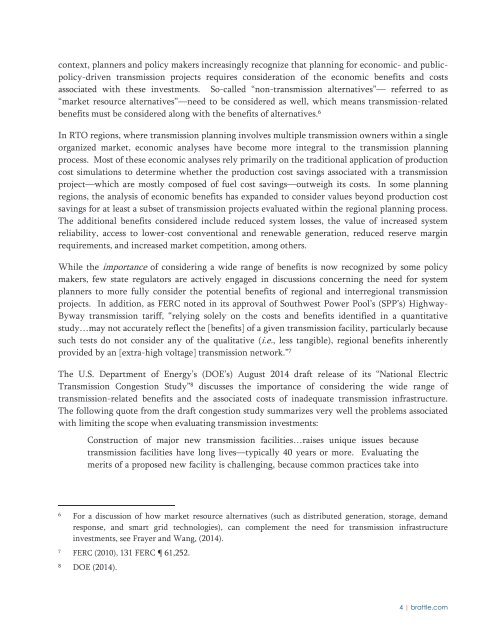THE BRATTLE GROUP
pvrbYG
pvrbYG
Create successful ePaper yourself
Turn your PDF publications into a flip-book with our unique Google optimized e-Paper software.
context, planners and policy makers increasingly recognize that planning for economic- and publicpolicy-driven<br />
transmission projects requires consideration of the economic benefits and costs<br />
associated with these investments. So-called “non-transmission alternatives”— referred to as<br />
“market resource alternatives”—need to be considered as well, which means transmission-related<br />
benefits must be considered along with the benefits of alternatives. 6<br />
In RTO regions, where transmission planning involves multiple transmission owners within a single<br />
organized market, economic analyses have become more integral to the transmission planning<br />
process. Most of these economic analyses rely primarily on the traditional application of production<br />
cost simulations to determine whether the production cost savings associated with a transmission<br />
project—which are mostly composed of fuel cost savings—outweigh its costs. In some planning<br />
regions, the analysis of economic benefits has expanded to consider values beyond production cost<br />
savings for at least a subset of transmission projects evaluated within the regional planning process.<br />
The additional benefits considered include reduced system losses, the value of increased system<br />
reliability, access to lower-cost conventional and renewable generation, reduced reserve margin<br />
requirements, and increased market competition, among others.<br />
While the importance of considering a wide range of benefits is now recognized by some policy<br />
makers, few state regulators are actively engaged in discussions concerning the need for system<br />
planners to more fully consider the potential benefits of regional and interregional transmission<br />
projects. In addition, as FERC noted in its approval of Southwest Power Pool’s (SPP’s) Highway-<br />
Byway transmission tariff, “relying solely on the costs and benefits identified in a quantitative<br />
study…may not accurately reflect the [benefits] of a given transmission facility, particularly because<br />
such tests do not consider any of the qualitative (i.e., less tangible), regional benefits inherently<br />
provided by an [extra-high voltage] transmission network.” 7<br />
The U.S. Department of Energy’s (DOE’s) August 2014 draft release of its “National Electric<br />
Transmission Congestion Study” 8 discusses the importance of considering the wide range of<br />
transmission-related benefits and the associated costs of inadequate transmission infrastructure.<br />
The following quote from the draft congestion study summarizes very well the problems associated<br />
with limiting the scope when evaluating transmission investments:<br />
Construction of major new transmission facilities…raises unique issues because<br />
transmission facilities have long lives—typically 40 years or more. Evaluating the<br />
merits of a proposed new facility is challenging, because common practices take into<br />
6<br />
For a discussion of how market resource alternatives (such as distributed generation, storage, demand<br />
response, and smart grid technologies), can complement the need for transmission infrastructure<br />
investments, see Frayer and Wang, (2014).<br />
7<br />
FERC (2010), 131 FERC 61,252.<br />
8<br />
DOE (2014).<br />
4 | brattle.com


